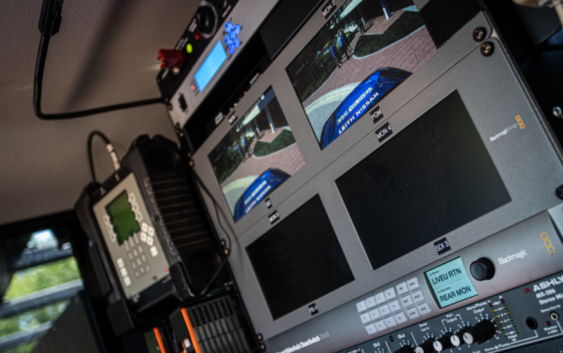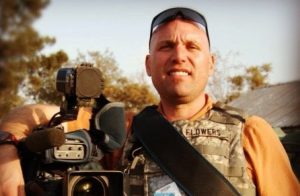- South Carolina residents with losses due to Hurricane Helene urged to apply for federal aid before January deadline
- North Carolina's I-40 closure from Hurricane Helene prolonged by new damage, detours in place
- Hurricane Helene survivor rebuilds life in Ashe County with community support
- Charlotte-based marketing agency announces $20,000 Creative Campaign Grant to help communities after Hurricane Helene
- Artists transform hurricane aftermath into hoop-inspired masterpieces at Charlotte exhibit
Inside the hurricane: WRAL crew chases Dorian’s progress from high-tech ‘Storm Tracker’

WRAL’s new “Storm Tracker” is getting quite an introduction to service, following Hurricane Dorian’s path up the coast from Savannah to Wilmington.
And its crew of three – anchor/reporter Kathryn Brown, photographer Chad Flowers along with Technical Project Coordinator Tony Gupton – is literally rocking and rolling down highways, using the specially modified 2019 Nissan Titan XD V8 crew cab pickup truck to deliver live meteorological updates beyond what the station has been able to do in the past.
The crew also is able to stay in better contact with home base through enhanced communications that are designed to deliver data and video in tough conditions as well as where cell service has been disrupted or is knocked out.
Inside the high0tech jammed Storm Tracker
“Our 360 cam [is] a great visual tool to show our viewers what is happening without putting our reporters in danger of lightning and wind,” says Aimee Wilmoth, WRAL weather executive producer.
“And our storm tracker will be able to go live from any location at any time since it is equipped with a satellite. We don’t have to rely on cell phones to get our reports on tv which is great, because sometimes with these tropical systems, cell towers are knocked out.”
The designer on board
The Stork Tracker, which just arrived at WRAL only days ago, was sent into the field this time without a meteorologist, but having Gupton along means that the person who designed it is along to ensure if something breaks it can be fixed.

Tony Gupton
“My role is to operate and keep this remote truck functioning and repaired especially in extreme conditions,” Gupton explains.
“I designed our Storm Tracker to be as user friendly as possible but to also handle a catastrophic situation where infrastructure has been destroyed. This remote truck can handle off road with heavy weather such as snow. It has a unique power system where the truck engine keeps a large battery system charged and can run all systems for up to 5 hours once fully charged and engine is off.”
From huge tires to stabilizers, the truck is packed with plenty of cutting-edge technology.
“Our Storm Tracker has a VSAT Satellite dish which allows us to downlink bandwidth off of a satellite for our bonded transmission devices up,” Gupton says.
“This is a much different method than traditional sat trucks of the past. Also, we have a very high res monitor built into the bed of this truck with full Doppler control allowing our meteorologist for the first time remote radar control, very cool!”
Not every new tool and radar is being used on the inaugural trip, Wilmoth points out. But the crew does have other technology to enhance reporting capabilities:
An aerial drone.
“Yes I do have a drone with us on this trip and I manage the WRAL Drone program of approximately 12 drones,” Gupton points out. He’s qualified to pilot the aircraft and he’s well aware of flight restrictions in storm areas.
Gear like periscopes inside the cab allow the crew of the Storm Tracker to scan outside conditions.
“I have my pilot’s license and can operate within the rules and laws of [FAA] guidelines,” he says. “Drones are fantastic tools that allow us aerial’s wherever we are at as long as we can fly legally and safely.”
Gupton sees the Storm Tracker and drones as signs of WRAL’s long-time commitment to using technology as a means to improve news coverage. But he also says there’s a strong commitment to safety.
“My next anniversary at WRAL TV will be my 40th. I love remote work and have covered every hurricane for WRAL except for one since Hurricane Hugo in the 1980’s,” he recalls.
“Honestly, it’s not just another day at the office but they all have tough winds, lots of rain with potential for injuries and damage. I treat them all the same.”
He has three guidelines:
“Try not to get myself or crew hurt.
“Try not to damage our equipment.
“And then get on the air.”

Chad Flowers from his LinkedIn page
The bottom line? “We will be ok if we can accomplish those three things in that order.”
As the storm unfolds and the Storm Tracker mission extends into multiple days, Gupton says he and the team are learning as they drive.
“This is the maiden voyage for our WRAL Storm Tracker, so we are all learning together about all the capabilities it has,” he notes.
“There is so much high tech onboard the Storm Tracker. In addition to the most powerful satellite dish in the country, the Storm Tracker also gives us instant access to radar and Doppler. A special tool mounted to the roof allows us to monitor current conditions from exactly where we are – including temperature, wind speed, rain, etc. There are also three cameras on board that allow us to more effectively show what we are seeing – and even beyond that.”
Reporting from the storm front
Brown, who typically co-anchors a mix of newscasts in the evenings on WRAL and Fox 50, is excited to have the chance to report on the move from inside a storm and to have access to all the gear Storm Tracker packs.

Kathryn Brown
“Anytime I see a storm in the forecast, I start preparing,” she says. “I have a ‘go bag’ filled with rain gear, boots, towels … I packed for several days, and as we are on the road, i am washing my clothes as we go, trying to conserve clear gear in case we lose power or end up stranded.
“Sometimes we sleep in hotels, sometimes we sleep in parking lots — we have to be prepared for anything.”
Not that reporting about big storms is new. She’s a veteran of many.
“As journalists we’ve always been something of storm trackers,” Brown says. But the Storm Tracker adds something – more safety.
“This new tool gives us the ability to do so much more from the field — and feel safer doing it.”
Over her career, Brown has covered “more than a dozen hurricanes, from the East Coast to the Gulf Coast.” And she hopes information the Stork Tracker team provides helps others stay safe.
“My hope is that by reporting on what is happening with the storm, people watching at home are able to better prepare, and/or more effectively alert their friends and neighbors who may be in the storm’s path about what to expect. We go into the danger zone so you don’t have to.”
‘Storm Tracker’ to take WRAL meteorologists into the eye of the storm